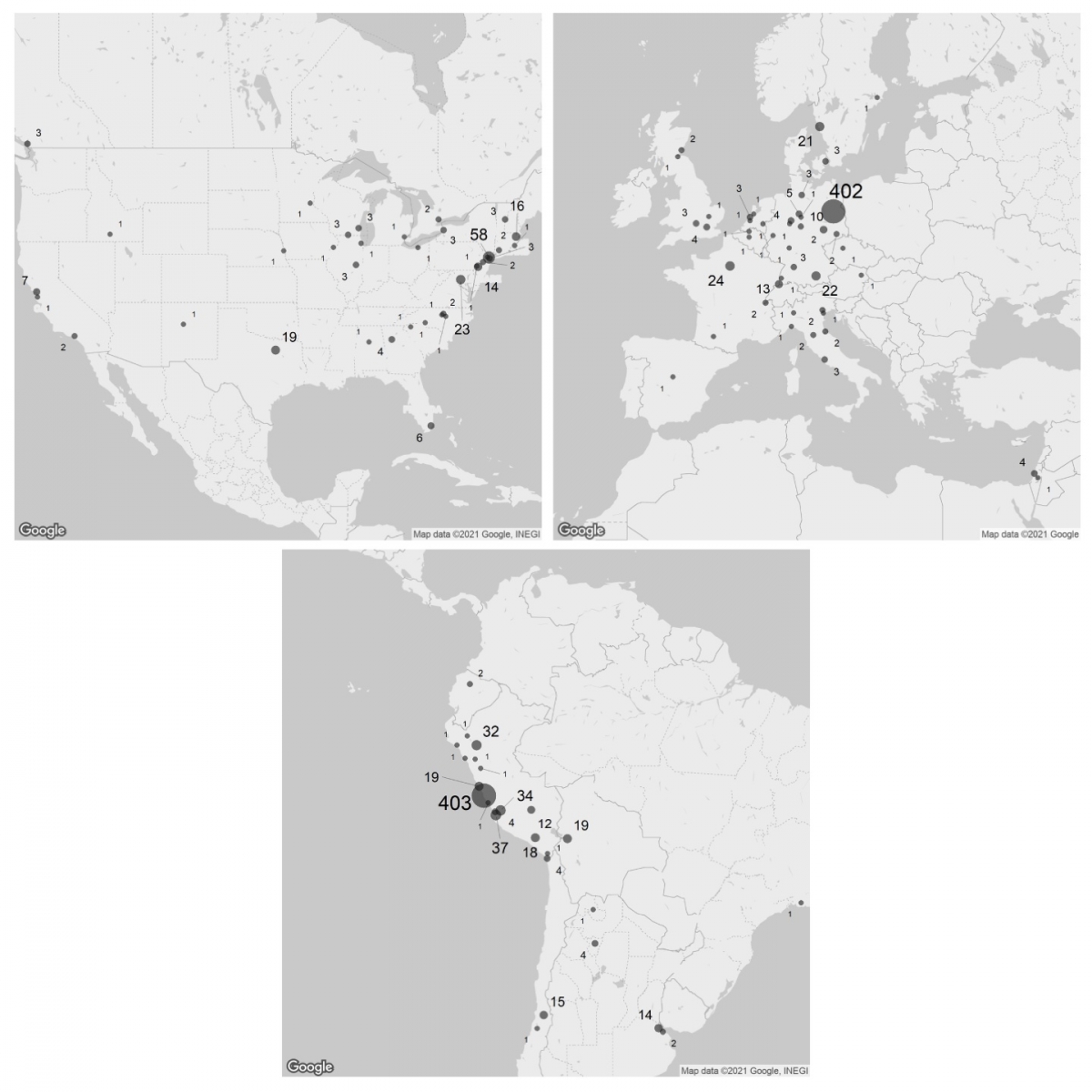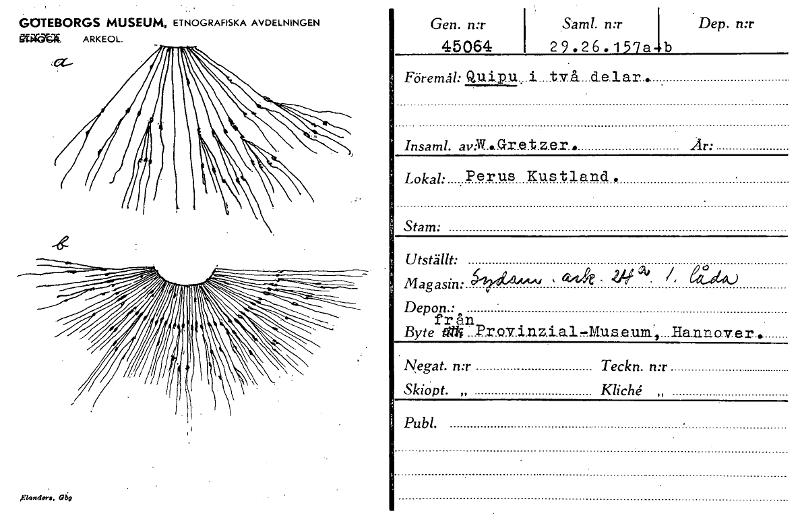- About MAA
- Membership
- MAA Publications
- Periodicals
- Blogs
- MAA Book Series
- MAA Press (an imprint of the AMS)
- MAA Notes
- MAA Reviews
- Mathematical Communication
- Information for Libraries
- Author Resources
- Advertise with MAA
- Meetings
- Competitions
- Programs
- Communities
- MAA Sections
- SIGMAA
- MAA Connect
- Students
- MAA Awards
- Awards Booklets
- Writing Awards
- Teaching Awards
- Service Awards
- Research Awards
- Lecture Awards
- Putnam Competition Individual and Team Winners
- D. E. Shaw Group AMC 8 Awards & Certificates
- Maryam Mirzakhani AMC 10 A Awards & Certificates
- Two Sigma AMC 10 B Awards & Certificates
- Jane Street AMC 12 A Awards & Certificates
- Akamai AMC 12 B Awards & Certificates
- High School Teachers
- News
You are here
Keys to Mathematical Treasure Chests: Andean Khipus – Museum Collections and Documentation
Two basic but important questions are worth addressing up front: How many khipus survive today? Where are they located? As of 2021, I have found there to be at least 1,386 khipus in 143 museums and private collections in over 20 countries (see Figure 2). These are tabulated in an online appendix accompanying my recent book, which introduces non-specialist readers to khipus and khipu research [Medrano 2021b]. Additional specimens continue to emerge from ongoing archaeological work in the Andes, with Inka-era accounting contexts particularly well-represented in recent years (e.g., Barraza Lescano, Areche Espinola, and Marcone Flores [2022]; Clindaniel [2019, chap. 4]). Most khipus in museum collections were excavated on the Peruvian coast between the late 19th and early 20th centuries, with hundreds removed from the Andes and subsequently deposited in North America, Europe, and Asia.

Figure 2. Andean khipus in museums and private collections (maps by Manuel Medrano).
Some collections are grouped by geographic proximity; see [Medrano 2021b].
Fortunately, many, if not most, khipus from among the global corpus have been photographed and can be found online. The museum databases associated with the largest khipu collections are a logical starting point; each online platform offers distinct benefits to interested users.
 Searching “khipu” on the collections portal of the Ethnologisches Museum, Berlin yields about 300 matches, with relatively large thumbnails arranged in a grid aiding high-level comparison. Most objects’ entries list the names of their collectors (largely Germans) and reported find spots. The larger khipus also have accompanying notes describing the arrangement of strings, their diameters, and their colors, for the most part written in English. To find especially high-resolution images of several khipus in the Berlin collection, see the portfolio produced for MacGuffin Magazine by Mathijs Labadie, a Rotterdam-based photographer. The accession numbers for several of the specimens can be found by zooming in on the affixed tags. Entering the numbers into the Berlin collections portal will then yield further information.
Searching “khipu” on the collections portal of the Ethnologisches Museum, Berlin yields about 300 matches, with relatively large thumbnails arranged in a grid aiding high-level comparison. Most objects’ entries list the names of their collectors (largely Germans) and reported find spots. The larger khipus also have accompanying notes describing the arrangement of strings, their diameters, and their colors, for the most part written in English. To find especially high-resolution images of several khipus in the Berlin collection, see the portfolio produced for MacGuffin Magazine by Mathijs Labadie, a Rotterdam-based photographer. The accession numbers for several of the specimens can be found by zooming in on the affixed tags. Entering the numbers into the Berlin collections portal will then yield further information.
 Another panoramic view is available through the online catalog of the Museo Nacional de Arqueología, Antropología e Historia del Perú (MNAAHP), which holds the world’s second-largest khipu collection. Searching “quipu” returns some 110 of the MNAAHP’s 200+ specimens. Some entries are accompanied by close-up images, especially of the complex, horizontal primary cords from which the strings hang on most examples. A comprehensive, quantitative survey of the MNAAHP khipu collection was carried out about a decade ago [Adawi Schreiber et al. 2011]. Several specimens from the collection are also included in a recently-published, freely-available catalog of 78 khipus in dozens of museums, with photographs that highlight their various styles and formats [Pancorvo 2020, pt. 2].
Another panoramic view is available through the online catalog of the Museo Nacional de Arqueología, Antropología e Historia del Perú (MNAAHP), which holds the world’s second-largest khipu collection. Searching “quipu” returns some 110 of the MNAAHP’s 200+ specimens. Some entries are accompanied by close-up images, especially of the complex, horizontal primary cords from which the strings hang on most examples. A comprehensive, quantitative survey of the MNAAHP khipu collection was carried out about a decade ago [Adawi Schreiber et al. 2011]. Several specimens from the collection are also included in a recently-published, freely-available catalog of 78 khipus in dozens of museums, with photographs that highlight their various styles and formats [Pancorvo 2020, pt. 2].
For those interested in the history of khipu collecting, several institutions have made available scans of the hand-written accession cards produced in conjunction with the khipus’ depositings.
 The American Museum of Natural History (AMNH) in New York, home to the third-largest khipu collection, lists 115 specimens under the label “kipu” on its collections search portal. In the default “list” view, pay special attention to the bottom-left corner of each result for mentions of “Tag/Textile Cards.” When this term appears, clicking on its hyperlink displays an image of each object’s accession card, including handwritten commentary and original photographs from a collection—deposited in the AMNH in 1901—of Eduard Gaffron, a German ophthalmologist who was a prolific collector of Andean material culture [Gänger 2014, p. 111].
The American Museum of Natural History (AMNH) in New York, home to the third-largest khipu collection, lists 115 specimens under the label “kipu” on its collections search portal. In the default “list” view, pay special attention to the bottom-left corner of each result for mentions of “Tag/Textile Cards.” When this term appears, clicking on its hyperlink displays an image of each object’s accession card, including handwritten commentary and original photographs from a collection—deposited in the AMNH in 1901—of Eduard Gaffron, a German ophthalmologist who was a prolific collector of Andean material culture [Gänger 2014, p. 111].
The AMNH khipus have played a crucial role in the history of khipu research. Leland Locke’s [1912] initial decipherment of the knot-based numerical system referred to AMNH khipu B/8713 (not currently digitized in the AMNH portal), as well as a broader corpus of samples. Among the latter was B/8715 (available by searching “B/8715”), which Locke [1923, p. 5] later described as “an example of the same advanced development as shown in [B/8713].” In the AMNH catalog, B/8715’s entry includes an accompanying accession card that notes the khipu’s lending to Locke’s academic advisor, mathematician David Eugene Smith, in November 1911.
 Slightly more detailed provenance information (and high-quality images) can be found in the extensive collection entries for the khipus in the Phoebe A. Hearst Museum of Anthropology at UC Berkeley. These were excavated from graves in the Ica Valley (southern Peruvian coast) at the turn of the 20th century by German archaeologist Max Uhle, on a “road between Chulpaca & Tate,” per the digitized accession cards. The most complete study of the Hearst specimens was carried out several decades ago by anthropologist Carol Mackey [1970, chap. 5], a UC Berkeley graduate student at the time.
Slightly more detailed provenance information (and high-quality images) can be found in the extensive collection entries for the khipus in the Phoebe A. Hearst Museum of Anthropology at UC Berkeley. These were excavated from graves in the Ica Valley (southern Peruvian coast) at the turn of the 20th century by German archaeologist Max Uhle, on a “road between Chulpaca & Tate,” per the digitized accession cards. The most complete study of the Hearst specimens was carried out several decades ago by anthropologist Carol Mackey [1970, chap. 5], a UC Berkeley graduate student at the time.
 Rounding out the historical museum resources are the well-documented khipus of the Museum of World Culture (Världskulturmuseet) in Gothenburg, Sweden. On the Museum’s collections portal, searching “quipu katalogkort” returns an assortment of historical khipu photographs (most are from the 1920s). Scrolling down or clicking the “Arkivdokument” filter yields 30 original accession cards, many of which contain striking drawings of samples in the Gothenburg collection. Figure 3, for example, reproduces a “khipu in two parts” received in an exchange from the Niedersächsisches Landesmuseum Hannover, Germany, in 1929.
Rounding out the historical museum resources are the well-documented khipus of the Museum of World Culture (Världskulturmuseet) in Gothenburg, Sweden. On the Museum’s collections portal, searching “quipu katalogkort” returns an assortment of historical khipu photographs (most are from the 1920s). Scrolling down or clicking the “Arkivdokument” filter yields 30 original accession cards, many of which contain striking drawings of samples in the Gothenburg collection. Figure 3, for example, reproduces a “khipu in two parts” received in an exchange from the Niedersächsisches Landesmuseum Hannover, Germany, in 1929.

Figure 3. Accession card for a “khipu in two parts” (1929.26.0157a-b) in the
Museum of World Culture, Gothenburg (© Världskulturmuseet, made available via
Creative Commons Attribution-NonCommercial-NoDerivs 2.5 License). See the online record
at https://collections.smvk.se/carlotta-vkm/web/object/1365111.
Manuel Medrano (Harvard University), "Keys to Mathematical Treasure Chests: Andean Khipus – Museum Collections and Documentation," Convergence (August 2022)




